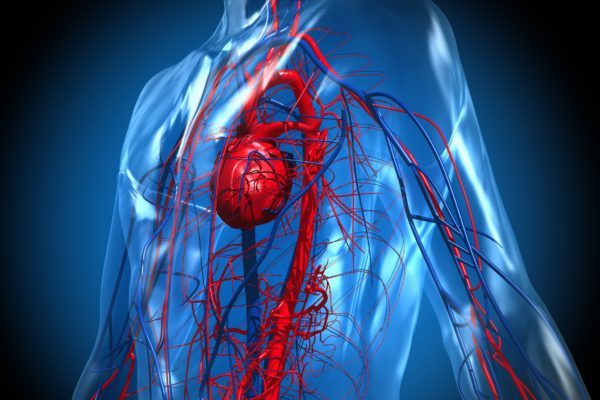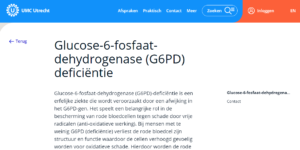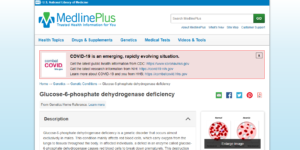Clinical picture
Glucose-6-phosphate dehydrogenase (G6PD) deficiency (G6PDD) is an inherited metabolic disorder. The disease is caused by a defect in the G6PD gene, resulting in a glucose-6-phosphate dehydrogenase (G6PD) enzyme deficiency. Metabolism refers to all the chemical reactions in the body to convert or use energy. These reactions take place throughout the whole body. In the setting of an enzyme deficiency, metabolism is impaired. G6PD is a protein located on the cell membrane of the red blood cells (erythrocytes) and protects the red blood cell against harmful influences of superoxide and hydrogen peroxide. In people with G6PD deficiency the red blood cells lose their structure and function, resulting in increased sensitivity of these cells for oxidative damage. The red blood cells are then degraded faster than normal and anemia can occur. Most of the time, patients with G6PD deficiency have no symptoms. Therefore, it is better to talk about an enzyme defect rather than a metabolic disease. Sometimes G6PD deficiency is called favism, a haemolytic response to the consumption of fava beans, because all individuals with favism show G6PD deficiency.
G6PDD is the most common enzyme defect worldwide. It was estimated that there are 400 million people with this enzyme deficiency. In 10 to 20% of people from Central Africa, countries surrounding the Mediterranean Sea, the Middle East and the Far East G6PD deficiency is found. The enzyme defect has an additional effect, namely that people with this defect are resistant to malaria. As a consequence, the incidence of G6PD deficiency is high in African and Asian countries. How many people in the Netherlands are affected is unknown.
The two most common forms of G6PD deficiency mostly affect men of African origin (G6PD-A(-)), or men from countries surrounding the Mediterranean Sea (G6PD-Mediterraenan).
Symptoms
The signs and symptoms of G6PD deficiency may vary from one person to the next. G6PD is categorised clinically by the severity of the anaemia the patient experiences, with some patients only showing mild symptoms, whilst others have severe symptoms which may require hospital admission. G6PD deficiency can come to light right after birth. These patients have chronic anemia and jaundice as a result of concomitant problems with the excretion of bilirubin, a degradation product of hemoglobin. The latter is associated with Gilbert’s syndrome in adults.
Some G6PDD patients only occasionally or even never experience anaemia, only in periods of physical stress such as shortly after birth, with fever, infection or after the use of medication. This is referred to as acute anaemia.
The most common symptoms are associated with anaemia:
- Fatigue, weakness, and paleness due to reduced levels of red blood cells.
- Fast or irregular heartbeat, due to the fact that the heart must pump harder in an attempt to circulate the reduced amount of oxygen through the body.
- Excessive breakdown of red blood cells (haemolysis) causes the formation of higher levels of bilirubin than normal, resulting in the yellowing of the skin and white of the eyes. Jaundice occurs 1 to 4 days after birth.
- Bilestones and stomach ache. Painful bilestones can develop as a result of the high levels of bilirubin (from the breakdown of red blood cells).
Between episodes of haemolysis most patients have normal complete blood count.
Cause
G6PD deficiency is caused by a defective gene coding for the enzyme glucose-6-phosphate dehydrogenase. G6PD deficiency is an X-linked recessive disorder; the G6PD gene is located on the X chromosome. Therefore, patients with symptoms are almost exclusively males. Men with one affected X-chromosome are always affected, while women have two copies of the X chromosome. In men with G6PD deficiency, the G6PD activity can be slightly diminished or totally absent.
Because women have two copies of the X chromosome, they normally do not show symptoms when one X chromosome is affected. In this case she is carrier of the disease and can pass it on to her offspring. The G6PD activity is normal in carriers. X-inactivation, also called lyonisation, is a process by which one of the copies of the X chromosome is inactivated. When this happens, carriers can have symptoms of the disease. Even more rare is a woman with two affected X chromosomes. Her clinical picture is the same as in men with the disorder.
Diagnosis
The diagnosis can be made based on the activity of the enzyme glucose-6-phosphate dehydrogenase in red blood cells. During haemolytic periods, the G6PD activity can be misleadingly high due to the higher enzyme concentration in reticulocytes (immature red blood cells). Their levels are comparatively high in the blood in response to the destruction of mature red blood cells. A defective G6PD enzyme can easily be detected by laboratory research on the red blood cells.
The diagnosis is based on the following tests and research:
- Structured medical history.
- Physical examination.
- Blood tests:
- Total blood count. Determining the nature and severity of anaemia, haemoglobin level.
- Reticulocyte (immature red blood cells) count. Determine reticulocyte production index in the bone marrow. A person with haemolytic anaemia has a higher production index due to the increased destruction of red blood cells.
- Blood smear. Test to check on abnormally shaped red blood cells. Red blood cells that contain grains of oxidized haemoglobin (Heinz bodies).
- Liver function tests to check on proportion of haptoglobin and bilirubin. After destruction of the red blood cells, the released iron is bound to the haptoglobin protein. Low levels of haptoglobin are an indication for increased red blood cell destruction.
- Determination of G6PD levels and activity of the PK enzyme.
Treatment
There is no medicinal cure for G6PD deficiency. Treatment of this disorder consists of prevention of haemolysis by avoiding oxidising agents, chemicals and other substances, such as:
- Certain anti-malarial medication (dapsone, primaquine; chronic patients: also chloroquine, hydroxychloroquine, and kinin).
- Antibacterial agents (quinolones, co-trimoxazole, nitrofurantoin, silver sulfadiazine; chronic patients: also sulfasalazine).
- Painkillers/fever reducers (phenazopyridine; chronic patients: also acetylsalisylic acid and paracetamol).
- Other substances: methylthionine, prilocaine/lidocaine rasburicase, tolonium, broad beans; chronic patients: also ascorbic acid, chloramphenicol, vitamin K, glibenclamide, hydroquinine, isoniazide, isoniazid, isosorbide dinitrate).
- Naphtalene (main ingredient of mothballs).
Furthermore, supportive measures are required for neonatal jaundice and hemolytic episodes:
- Hydration (fluid resuscitation), to prevent damage to the kidneys.
- Blood transfusion or exchange transfusion (erythrocytapheresis) in order to improve the oxygen transport capacity of the blood.
- Blood transfusion for patients who have signs of anemia. A possible complication of blood transfusion is iron overload (too much iron in the blood).
- Exchange transfusion: at first half a liter blood is removed from the body, after which donor blood is given. This will reduce iron overload.
- Plasmapheresis: exchange of blood plasma of the patient through that of a healthy donor.
Additional information
Related articles

Clinical picture

Symptoms

Cause

Diagnosis

Treatment

Patient organisations

Links









